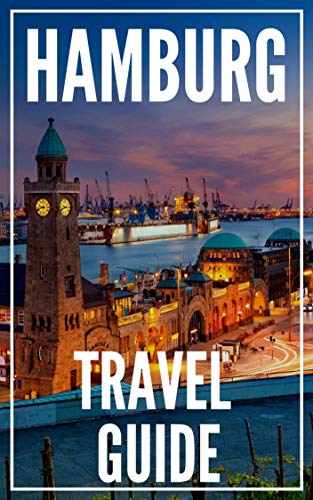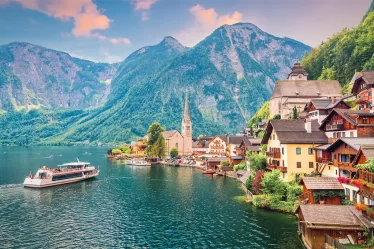
Hamburg was the city we were most curious about after Berlin and Munich in Germany. We couldn’t resist this extremely ‘cool’ port city, which has a different architecture compared to Germany in general, a lifestyle that looks like a Danish city and a full cultural richness, and by dedicating two days of our Berlin trip to Hamburg, we finally met Hamburg! Walking around this city built around the Elbe River is indeed the best option; While walking through the city between canals and bridges, what we saw, tasted and the northern air of Hamburg were very good for us!
We’re talking about a city that is home to Germany’s second largest city and largest port. Like every port city, Hamburg has its own rich character; but of course, Hamburg’s proximity to the Nordic countries and its past have also been very effective in its current stance. If you want to visit a well-developed European city where all these features are felt together, the city dynamics never ends, get ready; We’re going to Hamburg, which offers the perfect route!

PLACES TO SEE IN HAMBURG
A plan of at least 2 full days, 3-4 days if possible, would be good to visit Hamburg. To see the orange-red architecture of the city to the fullest, and to take a stroll through the canals, it is best to take a good walking route. You can divide the plan for the walking route into the old and new parts of the city, as we did.
#1 JUNGFERNSTIEG
Let’s start the walking route with the Jungfernstieg. Most of the Jungfernstieg, one of the city’s most important boulevards, is located in Hamburg’s new district called Neustadt, but stretches to the east of the Altstadt, its old district and old town. Since this place is like a central point, you can see many attractions, shops and even shopping malls around it.
The boulevard stretches around Binnenalster Lake, one of the city’s artificial lakes fed by the Alster River, so witnessing the beautiful city views while walking around the area called Little Alster is a bonus of the tour.

#2 HAMBURG RATHAUS
Since we followed our walking route, we started the Hamburg Places to Visit list with Jungfernstieg boulevard; but of course the real opening will be with the town hall Rathaus. 😊 Hamburg Rathaus, one of the most magnificent buildings in the city, and even one of the most eye-catching city halls in Europe, is a point where you will definitely drop by. You are used to the views of the huge square right in front of the giant city hall from other European cities you have already visited; here is such a place! It should definitely be on your route with its Neo-Renaissance style architecture, which was completed in 1897, and its courtyard is also extremely pleasant.
#3 HAMBURG OLD TOWN
We have also included some spots in the old city center of Hamburg in our list; but let’s gather the places that should be on your walking route, especially for those who want to see this part of the city, under this heading. Start Hamburg’s old town route with Hamburg Rathaus , continue by crossing the Börsenbrücke and Trostbrücke bridges. From here on out, once the tallest structure in the world, St. You will see the Nikolai Monument , the Hopfenmarkt , which was an important barter market in the past, the Deichstrasse where Hamburg’s oldest houses are , and then the Speicherstadt , which is the warehouse district . Chilehaus _ building, one of the most important churches of the city, St. You can end with Catherine .

#4 MÖNCKEBERGSTRASSE
Mönckebergstrasse, one of Hamburg’s main shopping streets; It is located in the Altstadt district, between the Rathaus and the train station. It is a pedestrian zone and is home to many national and global brand shops, Scandinavian designer boutiques and Hamburg-style cafes. We wanted to recommend this place not only for shopping, but also for seeing Hamburg’s Northern-influenced brands. It is a place to wander around to have an idea about the general atmosphere of the city.

#5 ST. MICHAELIS CHURCH
st. Michaelis is Hamburg’s most famous church. This church, which is a 15-minute walk from the Rathaus, is most popular for its tower. You can watch and photograph the city with a panoramic view from the observation terrace of the 132 m tall tower. In particular, we think it is a place to be enjoyed by those who like to see the city from above.
You can go up the tower with 453 stairs or an elevator, the exit fee is the same either way. Another activity in the church is that the view terrace in the tower is open to visitors at night on some days. Although the price of this event, called Nachtmichel, is a little higher, it can be a different and enjoyable activity for a trip to Hamburg if you come across it.
st. Michaelis Church is free to enter. The tower terrace is open to visitors between 09:00 and 19:30 from May to September, between 10:00 and 17:30 from November to March, and from 09:00 to 18:30 in October. The entrance fee to the tower is €6 for adults and €4 for children. You can get information about the Nachtmichel night event at this site .
#6 ELBPHILHARMONIE
It’s time for the architecture we love most in Hamburg! Opened in 2016, the Elbphilharmonie is a mixed building with a concert hall, residential and hotel sections, built on Hamburg’s oldest warehouse built in 1875. It is mainly known for its concert hall and this beautiful building hosts numerous performances every year. In fact, the Gaye Su Akyol concert was held here when we were in Hamburg. It is also possible to encounter such surprises; However, let’s not forget that the tickets are sold out very quickly.
The building was designed by the Swiss architectural firm Herzog & de Meuron and cost €866 million. Although it is a very controversial project both financially and architecturally, we likened the Elbphilharmonie to Hamburg. The concert hall can be visited, and the building also has a viewing terrace. Both have an entrance fee, but if you want to choose one, you can choose the terrace part. The fee for viewing the terrace called the Plaza is €2 per person, but reservations must be made in advance and the ticket must be purchased online.

#7 SPEICHERSTADT
After Elbphilharmonie, let’s turn our route to Speicherstadt, Hamburg’s historical warehouse district, and HafenCity, Hamburg’s urban renewal district. When we say red buildings, places converted from warehouses, plenty of coffee shops, bridge views, it’s no wonder that Speicherstadt is one of our favorite areas in Hamburg. This gigantic warehouse area, which is on the UNESCO World Heritage List, is truly the winner of our hearts with its dazzling views. Randomly wander the streets of Speicherstadt, take a coffee break at Kafferösterei and take lots of photos in this area with many bridges. It is such a photogenic place anyway that we hardly think you can stop without taking a photo.
#8 HAFENCITY
When you come to Speicherstadt, you will also see HafenCity, which includes this region. HafenCity is Hamburg’s urban renewal district. When it comes to urban transformation, don’t expect anything standard; because it is considered the largest urban development project in Europe. The HafenCity project, which started in 2008 in Grosser Grasbrook, one of the former free ports of Hamburg, is aimed to be completed in 2025 and to be a region with 12.000 people and 40.000 people working.

#9 KAROLINENVIERTEL & SCHANZENVIERTEL
One of our favorite places to wander around Hamburg was the city’s hipster district, the Karolinenviertel. Karolinenviertel and its neighbor Schanzenviertel , as two innovative districts, own a plethora of beautiful spaces, abundant street art, photogenic landscapes and design boutiques. You may think that you are a little closer to the Berlin air here, but we can say that it still carries a Hamburg spirit. If you want to take a coffee break in this area, keep in mind Elbgold, one of the best coffee shops in the city.

#10 HAMBURG FISCHMARKT
Let’s recommend a pleasant experience activity for those who have enough time in Hamburg; the city’s fish market Fischmarkt! As a completely Sunday morning route, it requires waking up very early in the morning; however, if your trip falls on the weekend, we recommend it to be on your list. If you can go to the fish market on the Elbe at 06:00 in the winter and at 05:00 in the summer, you can watch the fish auction, which has become a Sunday ritual for Hamburg.
Visitors usually come here in the morning after the parties in this area on Saturday night and have breakfast with fish soup, fish bread and fish snacks. In this respect, the fish market is both a place to buy seafood and a popular last stop for Saturday nights. The auction ends between 08:00 and 09:00, but you have the chance to eat something besides the auction. Another thing you can do at the fish market is to attend the brunch with live music, which lasts until 12:00 on Sunday morning. It’s too expensive for us now, with a €22 per person reservation requirement, but still conceivable.

#11 HAMBURG PORT: LANDUNGSBRÜCKEN
If your trip to Hamburg doesn’t fall on the weekend like we did, you can skip the Fischmarkt plan and take a short walk in the harbor area of Landungsbrücken. You will end up here somehow, but we recommend that you go down to the port side to see the same harbor view as Fischmarkt and to eat fish and bread.
Landungsbrücken was once a pier for steamships. Today it is a central point for Hamburg’s train and ferry systems. While watching the harbor view, you will see that many sea vehicles pass through this route. If you want to do a harbor tour, let’s add that the tour boats also leave from here. The goal of our coming to this region was to eat fish and bread. You will see many fish and bread stalls throughout the harbor; our recommendation is to go to Brücke 10. Be sure to taste these sandwiches called Fischbrötchen, which look small but are served with a full fish portion.

#12 ELBE TUNNEL
Another place you can stop by in the port area is the 426 m long Elbe Tunnel. The Elbe Tunnel was opened in 1911 to connect Hamburg city center with the docks and shipyards in its south. The reason why it is added to the excursion routes is that it is open to both bicycle and pedestrian traffic; You can walk through the historical tunnel, the interior of which is covered with ceramics, to the opposite side. Of course, if your trip doesn’t coincide with the restoration, like we did… 😊

#13 ST. PAULI & REEPERBAHN
The Hamburg version of the Red Light in Amsterdam, St. The Pauli district is famous for its rebellious football team, subculture, and bustling nightlife and brothels around the Reeperbahn. In fact, we can say that this rebellious stance dominates the entire district; It is even possible to understand this from the graffiti, murals and anti-fascist graffiti that you will come across while walking around its streets. st. Pauli has had features that speak for himself both in the past and today. For example, this district was originally a quarantine zone built in the 17th century to protect the city from plague and leprosy. On the other hand, women are not allowed to enter Herbertstrasse around the red light, but it is not recommended for men to enter either. 😀 Here is such a place.
In addition to the ‘party hard’ nightlife of the Reeperbahn, one can visit theaters such as Schmidts Tivoli and Operetenhaus for cabarets and musicals. st. You can also see various fish restaurants, fish and bread buffets and boat tours around the piers in Pauli. Finally, the hipster Karolinenviertel district, which we mentioned in the travel list, is also very close to here; It is possible to visit these two regions together with their local design boutiques and pleasant places.

#14 HAMBURG MUSEUMS
Hamburg has many museums ranging from modern art to German classics, from ethnography to maritime, from coffee to miniatures. Established with the theme of immigration, Ballinstadt Emmigration Museum, Hamburg Museum dealing with 1200 years of Hamburg’s history, IMMH telling the maritime history in one of the oldest warehouses of the city, and International Maritime Museum, another museum on the same subject, presents the most important art works of Germany from the Middle Ages to the present. Kunsthalle, which hosts three different buildings, and Miniatur Wunderland, which is an ideal place for families with children, including the world’s largest railway model, are some of the most popular museums in Hamburg.


